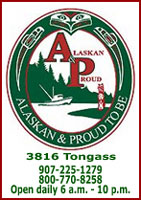|
Fish Factor U.S. Senate candidates facing off in popular fisheries debateBy LAINE WELCH
October 10, 2016
On Wednesday, October 12, five candidates for U.S. Senate will travel to the nation’s #2 fishing port to share their knowledge and ideas on a single topic: Alaska’s seafood industry. “It’s a great service to Kodiak, to our fishing communities and to Alaska in general,” said Trevor Brown, director of the Kodiak Chamber of Commerce, host of the event. “Fishing is the state’s largest private sector employer. I think the candidates realize the importance of the fishing industry and that its viability is very important to Alaska.” Since 1990 the Kodiak debates have been an election year tradition for candidates vying both for Alaska governor and Congress, and have always gotten 100 percent participation. Candidates facing off this go around include Republican Senator Lisa Murkowski, Joe Miller on the Libertarian ticket, Democrat Ray Metcalf and Margaret Stock and Breck Craig, both who are running as Independents. Debate moderator is Alaska Senator Gary Stevens (R-Kodiak); panelists posing questions are Julie Matweyou of Alaska Sea Grant, Julie Bonney, director of the Alaska Groundfish Data Bank, and Jeff Stephen, director of the United Fishermen’s Marketing Association. Alaska’s fisheries are an important part of any sitting U.S. Senator’s oversight, as nearly 85 percent of the seafood poundage that crosses the Alaska docks comes from waters managed and funded by Congress and the federal government, meaning from three to 200 miles from shore. The fisheries debate, set for October 12 from 7-9pm, at the Kodiak High School auditorium, will be broadcast and live streamed from host station KMXT/Kodiak and provided statewide via the Alaska Public Radio Network. Tune in at www.kmxt.org/ Bad crab news Bering Sea crabbers got the bad news they expected – low catch quotas and a canceled Tanner fishery for the 2016/17 season. State managers announced last week that the catch for Bristol Bay red king crab will be just shy of 8.5 million pounds, down 15 percent from last year. For Bering Sea snow crab, the harvest limit was slashed nearly in half to 21.5 million pounds, the lowest catch in 45 years. Last year the total take was 40.6 million pounds, and it was nearly 68 million pounds the previous season. An even bigger hit to the crab industry will come from the closure of the bairdi Tanner crab fishery, which had been growing steadily and produced 20 million pounds last season. Biologists said not enough female crabs were seen during summer surveys to reach a minimum threshold needed to open the fishery. Crabbers believe the Tanners are still out there, but have relocated from the standard survey regions. The small blue king crab fishery at St. Matthew Island also was closed for the season. “With the bairdi Tanner fishery closed and no opening at St. Matt’s and with the cut backs - whatever problems are causing poor recruitment of snow crab are impacting other crab species as well,” said market expert John Sackton. The Bering Sea crab fisheries open October 15. Fish futures With a few exceptions, Alaska’s 2016 salmon season was tough on both buyers and sellers. But having less fish available for market means wild salmon is moving well through sales channels at home and abroad, and plans are already underway for ramping up sales for next year, said Robin Samuelson, president of Ocean Beauty Seafoods which has operated in Alaska since 1910. “Our freezers will be empty by spring and we will be processing and buying very aggressively throughout the state,” Samuelson said, referring to the company’s six processing plants in Petersburg, Excursion Inlet near Juneau, Cordova, Kodiak and Bristol Bay. That’s contrary to recent rumors on the docks that Ocean Beauty is closing up shop, likely stemming from a big move being planned at its major office headquarters near Seattle. “We are closing our Union Street facility in Ballard and moving north,” Samuelson explained, adding that it also houses a plant where value added processing is done. “We’ve outgrown that facility and are experiencing substantial growth, and we are looking for a larger building that can accommodate that.” “We are always looking for more opportunities,” Samuelson said. “We know how much fishermen rely on us and we will be working with them for years to come.”
Laine Welch ©2016 Laine can be reached
at msfish[AT]alaska.com
Representations of fact and opinions in comments posted below are solely those of the individual posters and do not represent the opinions of Sitnews.
SitNews ©2016 Stories In The News Ketchikan, Alaska
|
|||



